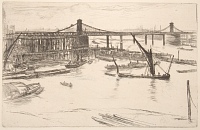Etchings Institutions search term: royal academy
Old Hungerford Bridge | ||
| Number: | 76 | |
| Date: | 1861 | |
| Medium: | etching and drypoint | |
| Size: | 140 x 215 mm | |
| Signed: | 'Whistler.' at lower right | |
| Inscribed: | no | |
| Set/Publication: | 'Thames Set', 1871 | |
| No. of States: | 4 | |
| Known impressions: | 65 | |
| Catalogues: | K.76; M.76; T.37; W.80 | |
| Impressions taken from this plate (65) | ||
PUBLICATION
12: The Athenaeum, 26 August 1871, pp. 280-81.
EXHIBITIONS
It was also shown by clubs for connoisseurs and collectors like the Union League Club in New York, to which Samuel Putnam Avery (1822-1904) lent a 'Rare proof; very delicate etching' (
 ). 16 Impressions were exhibited in Philadelphia in 1879 and, lent by Howard Mansfield (1849-1938), in 1902. 17
Bryan Lathrop (1844-1916) lent one to the exhibition organised by the Caxton Club in Chicago in 1900 (
). 16 Impressions were exhibited in Philadelphia in 1879 and, lent by Howard Mansfield (1849-1938), in 1902. 17
Bryan Lathrop (1844-1916) lent one to the exhibition organised by the Caxton Club in Chicago in 1900 ( ). 18
). 18
Possibly the bustling river scene with its steam ships and ferries, bridges and factories, appealed to industrialists, for an impression was lent by Messrs Mawson, Swan & Morgan to the Royal Mining, Engineering, and Industrial Exhibition (International and Colonial), Newcastle-upon-Tyne, in 1889 and one was included in the Art and Industrial Exhibition in Wolverhampton in 1902. C. Lewis Hind wrote appreciatively 'how good it is suddenly to come upon thirty etchings by Mr. Whistler, some of the Thames and Venice pieces, and other little masterpieces, so small yet so sufficient'. 19
13: See REFERENCES: EXHIBITIONS.
14: Thomas 1874 (cat. no. 37).
15: London Pall Mall 1874 (cat. no. 19); Liverpool 1874 (cat. no. 491).
16: New York 1881 (cat. no. 109).
17: Philadelphia 1902 (cat. no. 947 (80)).
18: Chicago 1900 (cat. no. 75).
19: C. L[ewis] H[ind], 'Art at Wolverhampton', The Academy and Literature, 19 July 1902.
 ). 20
). 20
20: New York 1898 (cat. no. 75).
21: Boston 1904 (cat. no. 64); New York 1904a (cat. no. 83); London Mem. 1905 (cat. no. 80).
SALES & COLLECTORS
Impressions of the first two states are very rare and appealed to a select group of major collectors, including Bernard Buchanan MacGeorge (1845?-1924), who acquired a first state (
 ). Second states went to George Aloysius Lucas (1824-1909) (
). Second states went to George Aloysius Lucas (1824-1909) ( ), Howard Mansfield (1849-1938) (
), Howard Mansfield (1849-1938) ( , which has not been located); and Francis Seymour Haden, Sr (1818-1910) (
, which has not been located); and Francis Seymour Haden, Sr (1818-1910) ( ), the latter ultimately going to Charles Lang Freer (1856-1919) in 1898. Freer had a third state already, bought in 1888 from Frederick Keppel (1845-1912) (
), the latter ultimately going to Charles Lang Freer (1856-1919) in 1898. Freer had a third state already, bought in 1888 from Frederick Keppel (1845-1912) ( ) and from the same source he acquired a cancelled impression in 1896 (
) and from the same source he acquired a cancelled impression in 1896 ( ).
).The main edition was printed in the third state, and some three dozen impressions have been located. Public collections bought good representative impressions. The British Museum was the first, in 1874 (
 ). E.D. Wallace (fl. 1871-1887), American, poet, novelist and writer on art, reported in considerable detail on a visit to the British Museum to see Whistler's works:
). E.D. Wallace (fl. 1871-1887), American, poet, novelist and writer on art, reported in considerable detail on a visit to the British Museum to see Whistler's works:24: 'Mr Whistler's Paintings', Baltimore Gazette, after 1 April 1876, in GUL PC1/75; partially quoting E.D. Wallace, 'The Fine Arts Abroad', Forney's Weekly Press, Philadelphia, 1 April 1876.
 ); Constantine Alexander Ionides (1833-1900) bequeathed a good example to the Victoria and Albert Museum in 1901 (
); Constantine Alexander Ionides (1833-1900) bequeathed a good example to the Victoria and Albert Museum in 1901 ( ); the Museum of Fine Arts, Boston, bought one in November 1897 (
); the Museum of Fine Arts, Boston, bought one in November 1897 ( ) and Obach & Co., London print dealers, sold another to the Kupferstichkabinett, Berlin, for £9.0.0 in 1902 (
) and Obach & Co., London print dealers, sold another to the Kupferstichkabinett, Berlin, for £9.0.0 in 1902 ( ).
).
